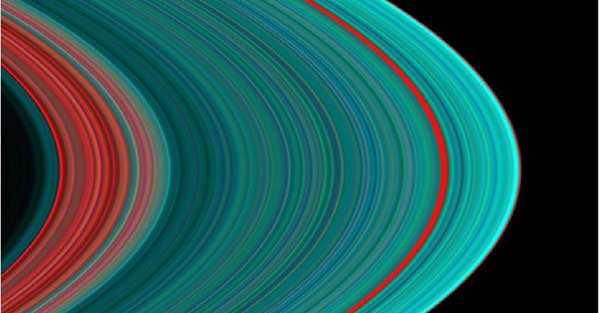
Saturn, planet of beautiful rings, has 62 known moons, nine yet to be named. The celestial body the ancients named Saturday for, it’s the sixth planet out from the Sun, beyond Mercury, Venus, Earth, and Mars (the terrestrial planets), and Jupiter. Like Jupiter, Saturn is a gaseous giant. Rock and ice form the core, but there’s no hard surface. The gases are mostly hydrogen and helium—like Jupiter, like the Sun. Saturn has almost the same diameter as Jupiter, but it’s much less dense. Even water is more dense than Saturn. If a bathtub could be found big enough to fit the planet, it would bob like a bathtub toy. This would be some bathtub, since Saturn is 755 times as big as Earth. Saturn orbits at a distance of 9.5 AUs—Astronomical Units—from the Sun (an AU is the distance between Earth and Sun). Each orbit takes about 30 years.
The rings and ringlets (perhaps 100,000 in all) may look like golden light, but they are composed of boulders, rocks, chunks of ice, and grains of dust. Some boulders in the rings are the size of a city block. The rings remain a mystery, but they may be bits of comets or moons that disintegrated before reaching the planet. Saturn’s rings are equatorial and thin, ranging from only 32 feet to about three-fourths of a mile, but they extend out for hundreds of thousands of miles. They each orbit Saturn at a different speed. Gaps separate some of the concentric rings, most conspicuously the Cassini Division, a more or less empty space between two major rings. The gap is likely caused by a little moon, Mimas (MY-mas), which exerts gravitational pull on particles orbiting twice as fast. This dance is called resonance, and it clears a space between rings.
Two of Saturn’s moons are candidates for life off Earth, a thrilling possibility. The moon Titan is remarkably Earth-like. It has a thick atmosphere composed of about 95 percent nitrogen and 5 percent methane. (Earth’s atmosphere is about 78 percent nitrogen. Earth’s 21 percent oxygen was put here by life.) On Titan there exist organic molecules, those that contain carbon and oxygen; water is frozen (the temperature is -290 degrees Fahrenheit). The rain is methane rain and the lakes are hydrocarbon lakes. The Cassini spacecraft (a joint project of NASA, the European Space Agency, and the Italian Space Agency) began orbiting Saturn in July 2004 and continues to report back on Titan and other moons.
Enceladus (En-SELL-a-dus) is another moon that could possibly contain life. It’s about 310 miles in diameter, has an atmosphere, and its albedo (reflectivity) is almost 100 percent. It’s a bright little thing. Its temperature is -330 degrees Fahrenheit. Wear a jacket. The south pole is warmer than expected. It has water vapor. Yes. Water vapor. There may be a salty, habitable ocean deep below the icy surface, this ocean being a possible explanation for towering ice plumes that shoot out from the moon’s south pole. Deep fissures in the ice exist at the south pole. One theory suggests that as Saturn’s tidal pull widens the cracks, water from this as-yet-unverified ocean spews forth. Parts of Enceladus have been recently resurfaced, meaning a hot interior and some sort of lava flow.
Enceladus has 84 named features, craters and such. Where, you might ask, do such things get their names? Why, from the International Astronomical Union. Anyone can make a suggestion, but the Working Group for Planetary System Nomenclature decides. Most old names are derived from Greek mythology. For example the moon Titan is named after the Titans, giant deities that warred against the Greek gods. Enceladus was a giant killed by a bolt of lightning thrown by Zeus. He’s buried under a mountain and when he turns over an earthquake (moonquake?) results. When he sticks out his tongue, a volcano erupts. But of late the Working Group has become more ecumenical, more culturally diverse, more worldly. The craters, fossae (channels), sulci (parallel grooves), dorsa (outer surfaces), and planitiae (plains) of Enceladus are named for characters and places in The Arabian Nights.
In that work, Shahrazad is the heroine, the storyteller. She’s the one who volunteers to wed the murderous king (who, in revenge for his cheating wife, marries and sleeps with a new maiden each night and slays her in the morning, until the people are in terror and the kingdom is running out of maidens). Shahrazad weds the king and in the middle of the first night begins telling a tale, so he, wishing to hear another story, delays putting her to death in the morning. This goes on for quite a few nights. In this ancient tale, she is one articulate, highly educated, clever woman, who had “read books of literature, philosophy, and medicine. She knew poetry by heart, had studied historical reports, and was acquainted with the sayings of men and the maxims of sages and kings. She was intelligent, knowledgeable, wise, and refined. She had read and learned” (Haddawy translation).
Shahrazad is also a crater on Enceladus. That one is my favorite.

